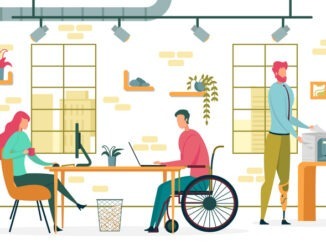
Creating an inclusive workplace goes beyond basic accommodations – it’s about fostering an environment where mobility challenges are understood, and solutions are integrated into business culture
Mobility challenges are one of the most prevalent physical disabilities in the UK, with an estimated 48% of the population experiencing some form of limited mobility. This issue can vary significantly, from mild difficulty walking to more severe cases. Mobility impairments can affect a person’s ability to move around and perform daily tasks, impacting their independence and ability to work. These challenges may be temporary, fluctuate throughout the day, or progressively worsen over time, requiring varying levels of accommodation.
The impact of limited mobility extends beyond physical movement; it can also have a profound effect on a person’s confidence, job performance and overall wellbeing. As the UK population ages, the number of people with mobility difficulties is expected to rise, highlighting the need for businesses to prepare for and accommodate these challenges.
Employers can play a critical role in supporting employees with mobility impairments by ensuring the workplace is accessible and adaptable to individual needs. This means understanding that each person’s mobility issues may manifest differently, requiring a tailored approach to support.
Here, we discuss how dealers can assist businesses in ensuring their workplaces are properly equipped to meet the evolving needs of individuals with mobility limitations.
Demonstrate Inclusivity Throughout
Businesses can show their commitment to inclusivity by creating adaptable spaces throughout the entire workplace, not just at desks or designated disabled areas. It’s important to consider the mobility needs of all employees in every part of the office, from communal spaces to break rooms. For instance, kitchens can be designed with lower fridges, counters and shelves to ensure wheelchair users can access them with ease. Additionally, adjustable-height meeting tables, ergonomic seating and adjustable chairs in meeting rooms ensures that employees with mobility challenges are comfortable in collaborative settings.
Understanding Different Needs
Mobility issues extend far beyond just difficulty walking; they can also include challenges with breathing, fine motor coordination, balance and more. It’s essential for businesses to consider a wide range of needs when creating an inclusive workplace. For example, non-trip mats in high-traffic areas can reduce the risk of falls, while assistive products like ergonomic grips for holding objects or specially designed pens and utensils can support individuals with fine motor coordination difficulties.
Adjustable furniture and specialised chairs with lumbar support can help maintain proper posture and relieve pressure, while anti-fatigue mats at workstations can reduce discomfort for those who need to stand for extended periods.
The most vital aspect of creating an inclusive workplace for those with mobility challenges is adaptability. Since mobility issues can fluctuate or change over time, it’s crucial that businesses incorporate flexibility in their design and policies.
By ensuring that adjustments are made throughout the entire workplace – from workstations to communal areas – companies can create a welcoming, accessible environment for all employees. This thoughtful integration not only supports current staff but also sends a clear message to visitors and potential employees that the company values inclusivity and is committed to accommodating the diverse needs of its workforce.



Be the first to comment